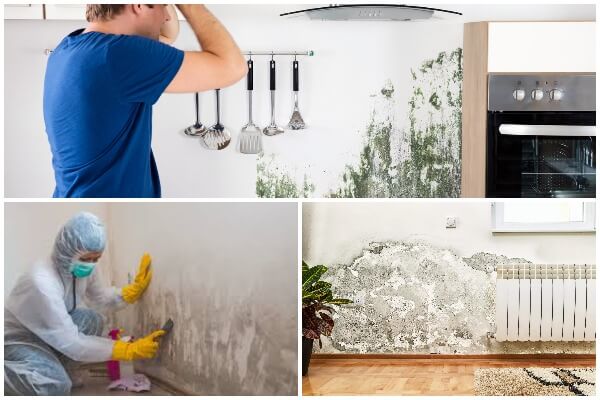
Mold is a common problem in many households, but figuring out why it won’t go away can be tricky. To help you out, here are 30 reasons that mold refuses to leave your home.
1. Poor ventilation: Mold loves warm and damp environments, so if your house has poor ventilation or limited air circulation, this can give mold the perfect opportunity to grow and thrive.
2. Leaky pipes: If you have any leaks in pipes or broken seals on windows, this allows water to seep into places unseen and create a favorable environment for mold growth.
3. Moisture buildup: In areas with high humidity levels, such as bathrooms, laundry rooms, or basements, moisture can accumulate and create a breeding ground for mold.
4. Clogged gutters: As water accumulates in your gutters, it can seep into walls or other areas of the house, creating an ideal environment for mold to grow.
5. Water damage: Any water damage, such as flooding or plumbing problems, can result in large amounts of moisture building up in an area, leading to mold growth.
Also Read: Understanding HVAC mold and how to deal with them?
6. Poor insulation: If your home is poorly insulated, warm air from outside can bring spores that will settle on surfaces and eventually lead to visible mold growth.
7. Overwatering plants: Plants need water to survive, but overwatering them leads to moist conditions that attract mold.
8. Poor drainage: If your home has poor drainage, water accumulates and provides the perfect environment for mold growth.
9. Sewage backups: Sewage backups can cause moisture and humidity levels to skyrocket, leading to a mold epidemic in your home.
10. Infrequent cleaning: Keeping your house clean is one of the best ways to ensure that no mold spores settle in unseen places and start growing over time.
11. Pet accidents: Accidents from your pets, such as urine or vomit left on carpets or furniture, can create damp conditions that are ideal for mold growth if not cleaned up quickly.
12. Failing roofing: If your roof is not doing its job properly, water can easily seep in and make it a prime spot for mold to thrive.
13. Clutter: Cluttered spaces create dark and hidden areas ripe for mold growth due to the lack of airflow and light exposure.
14. Unused appliances: Appliances such as washing machines or dishwashers left unused for long periods can develop mold over time due to the moisture they contain.
15. Poor basement waterproofing: Basements are prone to flooding, and if you have yet to waterproof your basement correctly, this can lead to mold building up in the area over time.
16. Humidifiers & Dehumidifiers: Humidifiers and dehumidifiers can cause a buildup of moisture in the air, which is an ideal environment for mold to grow.
17. Poor sunlight exposure: Sunlight helps dry out any damp areas in your home, and its absence can lead to mold growth.
18. Porous surfaces: Some materials, such as wood or concrete, are highly porous, meaning they can easily absorb moisture from the air, leading to mold growth if left unchecked.
19. Leaky windows: If your windows aren’t sealed properly, water can seep in and create a breeding ground for mold spores to settle and grow on surfaces.
20. Poor landscaping: Landscaping can play a big role in mold prevention. If your landscaping needs to be done properly and allows water to pool around the house, this can quickly lead to mold growth.
21. Old houses: Older homes were more prone to mold due to the lack of insulation available decades ago, so if you live in an older home, it pays to be extra vigilant about mold prevention.
22. Poor airflow: Areas with poor airflow, such as attics or closets, can create high humidity levels from trapped air, making them excellent environments for mold growth.
23. Dirty HVAC filters: Dirty air conditioning filters can cause moisture buildup within the system, which is ideal for mold growth if left unchecked.
24. Unvented clothes dryers: Clothes dryers not connected to a vent allow warm and moist air to spread throughout the home, making it an ideal spot for mold growth.
25. Poorly maintained HVAC systems: If your HVAC system is not properly maintained or serviced, it can quickly lead to mold and mildew in the ducts or other parts of the house.
26. Damp crawl spaces: Crawl spaces are prone to dampness due to their location, and if left unchecked, this can cause mold growth in these areas.
27. Inadequate ventilation: Without adequate ventilation in bathrooms, kitchens, and laundry rooms, the humid air can quickly become a breeding ground for mold.
28. Caulking issues: If your caulking is not done properly or begins to wear away over time, it can lead to moisture seeping in and creating an ideal environment for mold growth.
29. Condensation on windows: Windows are prone to condensation, which can quickly lead to mold if left unchecked.
30. Improperly installed insulation: If your insulation isn’t installed correctly or maintained, it can create pockets of dampness that are perfect for mold spores to settle and thrive in.
These are just some of the many reasons mold can refuse to leave your home. It is important to be aware of the potential issues that can lead to mold growth to take preventative steps and ensure a healthy environment for you and your family.
If you think you have an issue with mold in your home, it is best to contact a professional for help as soon as possible. A qualified mold remediation specialist will be able to assess the situation, determine the source of moisture, and provide a solution that will eliminate or reduce the risk of future mold growth.